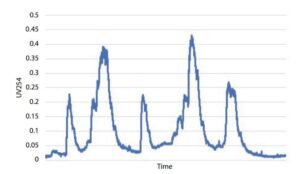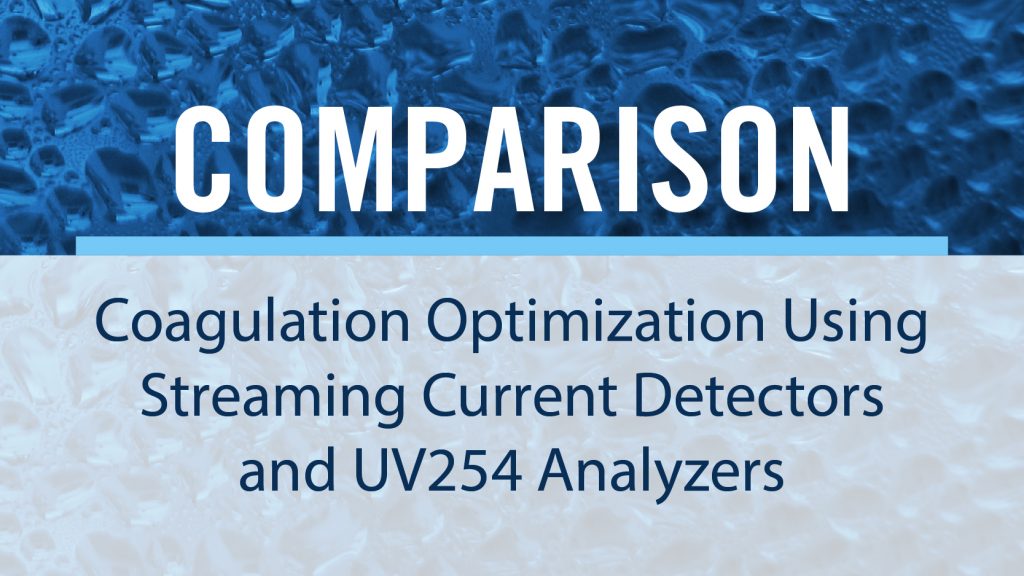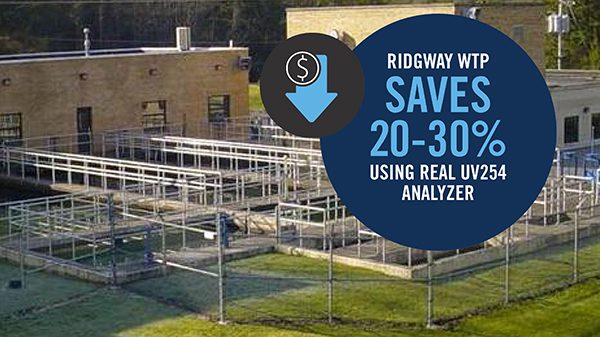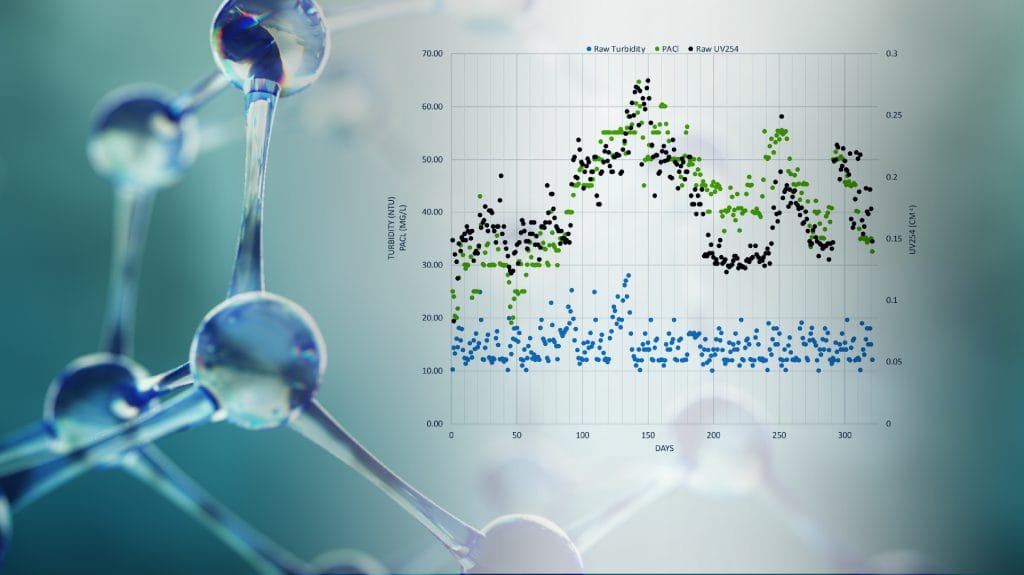Drinking water plants that use surface water or groundwater under the influence of surface water are susceptible to high levels of organic matter in the raw water. Reduction of organic matter through coagulation/ sedimentation and filtration plays a critical role in lowering the potential for disinfection by-product formation (DBP) and minimizing operational problems. Organic matter in water creates a high demand for coagulants significantly affecting the dose required for optimum coagulation. In addition, organic matter consumes disinfectants, such as chlorine or UV energy, reducing the efficiency of the disinfection process. Monitoring organic matter at the raw water intake enables you to:
- Rapidly detect raw water changes or events
- Optimize chemical dose to achieve cost savings from reduced chemical waste, decreased sludge production and disposal costs
- Lower potential for DBP formation by effectively removing reactive organics
- Improve water quality for downstream treatment processes
- More efficiently blend water from multiple sources
Real Tech’s UV254 and UV-VIS absorbance instruments provide continuous online measurement of organic matter, allowing the chemical dose to be controlled in response to current water quality conditions, decreasing the potential for both under and over dosing.
Download Coagulation Optimization for Drinking Water Treatment Application Note
OVERVIEW
Seasonal variations, heavy rainfall, or accidental contamination events can change the raw water quality in ways that are hard to predict (Figure 1). Online sensors that continuously monitor water quality are a plant operator’s best tools to determine the required coagulant dose of the plant based on the changes in raw water quality in real time.

Figure 1: UV254 absorbance in raw water sources can vary quite significantly over the course of a few days.
The benefits of optimizing the coagulation/flocculation process is multi-faceted:
- Coagulant chemical costs are reduced
- Sludge quality is improved while costs associated with sludge disposal are reduced
- Filter run times are extended (i.e., run-time between backwashes is longer)
- Background demand for disinfectants is reduced
- Optimized removal of natural organic matter (NOM) decreases the risk of exceeding disinfection by-product (DBP) limits in the treated water.
IMPORTANT WATER QUALITY PARAMETERS FOR OPTIMIZING COAGULATION DOSE
Many water quality parameters provide information relevant to coagulation including pH, temperature, turbidity, UV254, ultraviolet and visible (UV-VIS) absorbance, colour, total organic carbon (TOC), alkalinity and surface charge/zeta potential. However, the success criteria are usually based on removal of turbidity as standards for conventional treatment plants require turbidity to be less than or equal to 0.3 NTU in 95 percent of measurement. Therefore, turbidity is monitored continuously in many plants and often utilized for coagulation process control purposes.
Nonetheless, plants can benefit from monitoring organic matter in addition to turbidity for optimal coagulant dose control as in many cases organics contribute more to the total negative charge and create a larger demand for coagulants than particles (turbidity). This is especially true for raw water sources with a high specific ultraviolet absorbance (SUVA). SUVA provides an indication of NOM character and coagulation effectiveness for removal of organic matter. A SUVA greater than 2 indicates coagulant dosing is controlled by NOM rather than turbidity, and hence is applicable to the majority of water sources.
UV254 AND UV-VIS ABSORBANCE FOR ORGANICS MONITORING
Since NOM consists of various organic compounds and cannot be measured directly, technologies such as UV254 or TOC instruments are used for rapid or real-time measurement of organic matter. For coagulation optimization, UV254 is often a better parameter of choice over TOC.
UV254 provides an indication of the concentration of organic matter, specifically those that contain aromatic rings or unsaturated bonds (double and triple) in their molecular structures. Many organic compounds occurring naturally in the environment, such as humic substances, are aromatic and exist in high concentrations in surface water. These compounds are known to be a major precursor of DBP formation.
Therefore, UV254 provides one of the best indications of a water’s potential to form DBPs upon chlorine addition and should be monitored throughout the treatment process to ensure organics are removed. UV254 instruments also have the added benefits of lower capital and operating costs and greater ease of use over more complex TOC instruments.
In addition to monitoring absorbance at 254 nm, spectral information on absorbance values measured at several UV and visible wavelengths can be used to further support coagulation optimization. The benefits of UV-VIS monitoring stem from the fact that DBP formation depends on the reactivity of the organics present as well as the total amount of organic matter present. Using proprietary algorithms, manufacturers like Real Tech can characterize the NOM and provide information for a comprehensive control strategy to optimize coagulant dosing while minimizing the DBP formation potential.
WHERE TO MONITOR ORGANIC MATTER
Organics monitoring via UV254 or UV-VIS is of interest both before and after coagulation (Figure 2), and can be used to control and optimize the coagulation process by two mechanisms:
- Feed-forward control based on raw water quality (at source water intake or just before coagulation)
- Feedback control based on treated water quality (after sedimentation, or alternatively after filtration or before disinfection)
It is important to note that there is significant time lag between dosing and the separation processes, sedimentation, and filtration. This time lag can be in the order of hours for sedimentation. Therefore, when possible, the feed-forward control option should be preferred. In a feed-forward control system, the coagulant dose calculation is not affected by time lag, fluctuations in the flocculation process or coagulant mixing efficiency factors. The raw water quality parameters are the only variables that affect the coagulant dose calculation, and hence the response to changes in these parameters is immediate. This also results in more stable coagulant dosing.
PRACTICAL UV254 AND UV-VIS SOLUTIONS
Real Tech’s UV254 and UV-VIS instruments provide practical and affordable solutions for monitoring organic matter throughout the treatment process. Our real-time solutions enable timely detection of source water changes and events, allowing the coagulation process to be optimized for both solids and organic matter removal.
Discover more about Real Tech’s UV254 and UV-VIS spectral absorbance instruments for your coagulation optimization application.




